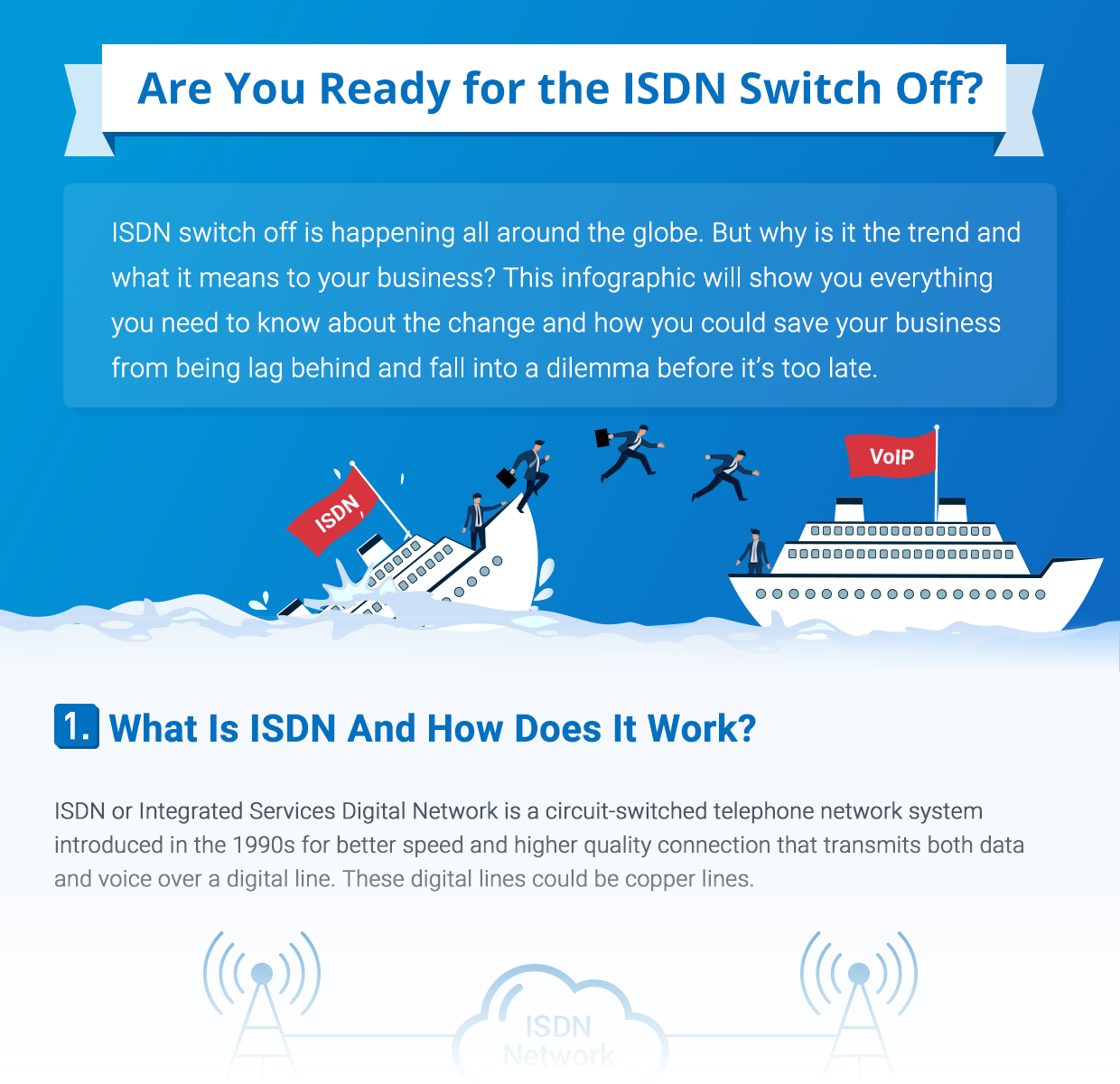
Download our infographic to grasp the key content of this topic!
When Is the ISDN Switch off?
The ISDN switch-off is happening all around the globe. The era of ISDN in the Australian telecommunications industry has come to an end. Deutsche Telekom AG is on its way to shut down all landline connections, and the whole process was finished by the end of 2019. BT ISDN is also coming to an end – British Telecom wants it to retire by the year 2025. Supplies for new PSTN and ISDN phone lines will cease from 2020. The intention is that any new telephone networks from 2020 will be IP based, and the traditional devices which do not support IP services would not be able to function anymore. So, finding a solution to the shutdown is now a trend for each SMB wishing to ensure a cost-effective and future-proof communications solution for its business.
What Is an ISDN Line?
ISDN stands for Integrated Services Digital Network, and it has been the initial internet service of high speed. It was a massive improvement for the service providers in the 90s, even considered to be revolutionary for internet use development. ISDN network utilizes a phone system, similar to the previously used dial-up internet service. Moreover, its properties became a standard for all the telephone network services.
It is worth knowing that ISDN was not only an enhancement of the dial-up system, but it was also a significant stage for developing the cable-modem internet service later. One can say it is a vital stage of internet evolution happening between dial-up and DSL/Cable. It modernized internet access and made it possible to use the high-speed network at home, and as time went by, providers started continuously improving their services to attract the attention of the customers.
Infographics: ISDN Switch Off
This infographic will show you everything you need to know about the ISDN switch off and things you could do to save your business from lagging behind before it’s too late.

In this article, you’ll learn everything you need to know about the ISDN switch off and what it means to your business.
Why Do Telecom Companies Switch Off ISDN?
As technology advances and business demands on telecommunications grow rapidly, the traditional PSTN and ISDN lines could no longer be able to meet all the expectations of business communications, gradually slipping further and further into obsolescence. Additionally, for ISDN providers, maintaining such an old infrastructure would cost them a lot, so it doesn’t make any sense to keep selling this outdated product.
Just like you won’t ride a bike made over 30 years to get you to and from your work every day, your voice traffic has to catch up with the trend and shift to use more advanced media. Everything has to move on. As service providers invest more in providing new and more advanced solutions for businesses, the legacy products are meant to fall into disuse.
What Will Replace ISDN?
Major telecom companies are switching from conventional fixed telephone network technologies to VoIP (Voice over Internet Protocol). Unlike the traditional PSTN or ISDN lines, which must rely on the landline to transmit voice and data, VoIP is a comparatively new technology that uses the internet to route calls, freeing your devices from being connected with physical lines and realizing robust unified communications features in a simple and effective way. With VoIP, copper lines and line rental would be redundant, and all you need to have is an active and stable internet connection.
What Are the Advantages of VoIP Compared with ISDN?
Switching from ISDN to VoIP is actually an evolution of modern telecommunications, so there must be some competitive advantages to migrate to VoIP. Here’s a list of advantages businesses could benefit from using VoIP services.
Lower Costs
Costs are one of the most important things to consider for any business. Let’s do the comparison, starting with the set-up fee. It’s always expensive to implement an ISDN system since it normally requires the purchasing of physical lines as well as proprietary phones and requires installation and maintenance by an experienced team. While VoIP does not necessarily require a desktop phone system and a hardware device, it’s much cheaper to install a VoIP system. Regarding the costs of phone calls, VoIP services providers always charge businesses by the number of users, with no phone calling limitations, while the traditional ISDN users need to pay for every call they make; it’s much cheaper for SMBs to use VoIP services. Generally, using VoIP services would save up to 50% online rentals and 25% on phone calls. So, for SMBs wishing to save money on their phone systems, VoIP would be a good option to choose from.
Flexibility and Scalability
According to a survey conducted by Software Advice, scalability is the top factor buyers would consider when evaluating a telephone system. So being flexible and scalable would be a great edge when competing in the market. For ISDN systems, once the set up is complete, it’s permanent and tied to ongoing contracts. If an organization is looking to expand the service to new locations, new hardware and lines are required to be installed at each location, which is normally done by an experienced team. So the changes could take weeks or even months and it would cost a lot. While for VoIP services, scaling up and altering the setup is quick and simple. Thanks to virtual numbers, the services are not tied to geographical locations and organizations can simply add on additional users without purchasing any new hardware or phone lines, enabling businesses to make the changes almost instantly, at a comparatively much lower cost.
Functionalities and Features
Though landline services do offer you some key features of a phone system like call forwarding, voicemail, call conferencing, and so on, these services always come at a cost and could not always satisfy the ever-growing business needs. VoIP systems also provide you with some other business-enhancing features, you can take a quick look here:
- AutoCLIP
- Auto Provision IP Phones
- CRM Integration
- Call Queue
- Call Recording
- Remote Management
- SIP Forking
- And more
Unified Communications
As businesses demand on real-time communications increase, Unified Communications has become a hot topic in recent years. With VoIP, communications service providers could help you interconnect all your communications devices and applications, realizing asynchronous communications and helping boost business productivity. A case in point is Yeastar Linkus Unified Communications App–a softphone working collaboratively with Yeastar S-Series VoIP PBX and Cloud PBX, which helps you to turn all your devices–your mobile phones, laptops, and computers, into an office extension, softphones could enable you to get calls anywhere at any time. With applications like Linkus, modern workers could free themselves from worrying about losing phone calls when they are on the go, and enjoy real-time communications features like instant messaging, file transfer, and so on.
Future Proof
As 4G now being accessible in most parts of the world and the introduction of 5G network not so far away, the speed and quality of internet services has been improved a lot, which leads to the overall enhancement of VoIP phone systems. The high quality of VoIP phone calls ensures users the best experience and all the easy-to-manage platforms VoIP empowers could only bring more to its users. Additionally, VoIP can use the internet to seamlessly merge data and voice technology, making it endlessly customizable, scalable, and cost-effective. So the future of telecommunications lies in VoIP.
What Should Business Do to Prepare for the Change?
ISDN switch-off is actually happening and systems that still use the old technology will lose out on the market share in a few years. So you need to take action before your ISDN services are completely shut down. Here we have some recommended solutions for you.
For customers with multiple communication needs:
If your traditional PBX is too old to continue serving you, or you are the one that goes with the tide of the time, then you should turn to fully VoIP enabled services. Yeastar provides you with the fully functional S-Series VoIP PBX which supports ISDN, PSTN, FXS, and VoIP terminals on an all IP-based connection. With Yeastar S-Series VoIP PBX, you shall experience all the latest, most comprehensive features of All-IP technology.
Recommend Products:
| S412 | 8 VoIP Users, 8 Concurrent Calls, Up to 4 CO/BRI Ports, up to 8 FXS Ports |
| S20 | 20 Users, 10 Concurrent Calls, Up to 4 FXS/FXO/BRI Ports |
| S50 | 50 Users, 25 Concurrent Calls, Up to 8 FXS/FXO/BRI Ports |
| S100 | 100 Users (expandable to 200), 30 Concurrent Calls (expandable to 60), Up to 16 FXS/FXO/BRI Ports |
| S300 | 300 Users (expandable to 500), 60 Concurrent Calls (expandable to 120), Up to 24 FXS/FXO/BRI Ports |
If you want to experience more advanced services and free your business from the physical devices, hosted PBX solutions would be a favored choice for you. Yeastar Cloud PBX could meet all your expectations, see full details here.
For traditional PBX customers:
If you are using the traditional PBX with a limited budget on a complete replacement of the existing devices, you can take a phased transition. Yeastar VoIP Gateways help with the transition by combining the traditional analog or ISDN PBX and analog devices with SIP service providers. The Yeastar VoIP Gateway VoIP migration portfolio includes TA Series Analog VoIP Gateway, TE Series PRI VoIP Gateway, and TB Series BRI VoIP Gateway. In this way, you don’t have to abandon your old traditional ISDN PBX and your business communication can be successfully transmitted to all IP-based technology.
Recommend Products:
| TA Series FXS VoIP Gateway | 4, 8, 16, 24, or 32 FXS Ports |
| TA Series FXO VoIP Gateway | 4, 8, or 16 FXO Ports |
| TE Series PRI VoIP Gateway | 1 or 2 PRI Ports |
| TB Series BRI VoIP Gateway | 2 or 4 BRI Ports |
How to Move?
The urgency of moving from ISDN to VoIP varies from business to business, and it could also be dependent on where your organizations locate. For businesses in European areas, it’s suggested to make the move at an early age, since service providers are already on their way to cut down ISDN services.
If you still have any doubts about moving from ISDN to VoIP, just click HERE to drop us a message. Act Now and you will have a chance to get a customized solution to ISDN switch-off for your organization.



